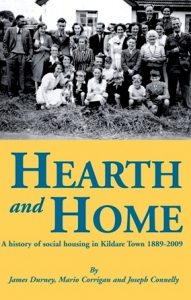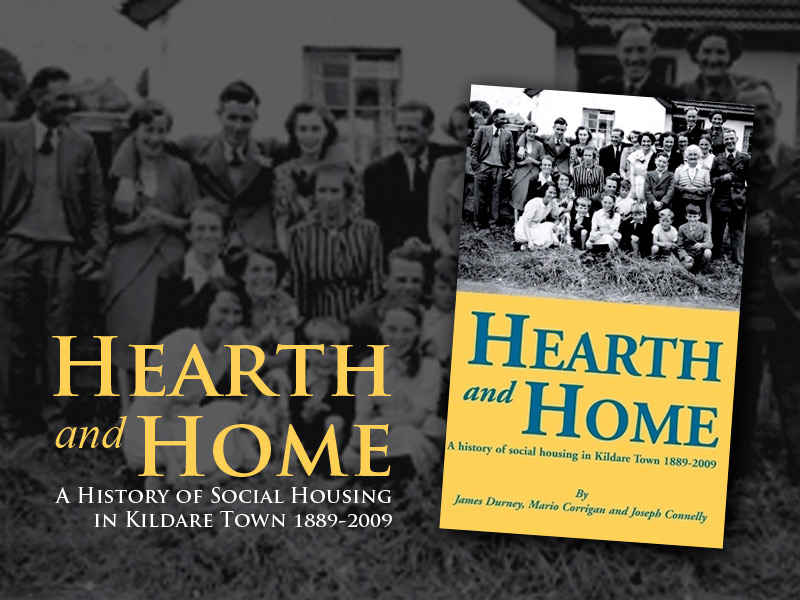
Three wise men arrived in Kildare last week. But the magi in question were not the Balthasar, Casper and Melchior of the Epiphany but instead bore the names of Durney, Corrigan and Connelly, three local historians bearing gifts in the form of copies of their new book on social housing in Kildare town.
The first-named, James Durney, has pioneered the study of council housing in County Kildare and his meticulous approach to documentary sources is augmented in the case of the Kildare town book by Mario Corrigan who has brought a new resource in the form of oral history, and by Joseph Connelly, an accomplished local historian and energetic organiser of the Cill Dara Historical Society. The resulting publication “Hearth and Home: a history of social housing in Kildare Town 1889-2009” thoroughly engages with not alone the policies and practicalities of housing in the town but also brings forward the human stories behind the headlines. The first-hand recollections by residents of the hardships involved with bad housing and of their delight when new houses were provided make for riveting reading. The family and community experience of the new estates is highlighted in the treasury of photographs from the early days. And the book will be a cherished resource for many Kildare folk through its listing of so many names of residents of the new estates – some 900 names are listed in the index making Kildare town one of the most thoroughly documented towns in the modern era.

The publication of the Kildare town book brings to three the number of studies on urban social housing in the county with Naas and Newbridge already documented by James Durney. The three books which focus on council houses provide a balance to the prolific coverage of the “Big House” in the history literature of Co Kildare. Earlier generations of historians devoted volumes to describing the circumstances of the mansions such as Castletown at Celbridge and Carton at Maynooth and of the privileged lives of their titled residents. Such extensive coverage was perhaps justified given that the “Big Houses” were at the centre of the local economies and had a major impact on the lives of the people living in their proximity. However it is wonderful that a new generation of historians should turn their skills to documenting the history of those who lived in the small houses of the labourer and the artizan. As well as the importance of such history to the locality it also provides insights into the political and social forces at work in Irish society.
While the new Kildare town book leaves no stone unturned in its chronicling of the story of council housing in the town it also serves as a guide to its wider and dynamic history. For instance in introducing a chapter on the planning of the Assumpta Villas scheme in the late 1940s the authors write that “ In 1948 the local newspaper recorded the departure for Australia of J.J. Murphy of Bishopsland House; the death of former publican, Thomas McWeeney; a petrol pump fire at Cunninghams; and the arrival of the first public telephone kiosk which would be in operation in 1949.”

This approach of linking the main theme of housing with the historical context of the times is evident from the opening chapter which summarises the beginnings of Kildare town from its illustrious status in the time of St Brigid and earlier. The narrative gets into its stride when drawing on sources to describe the appalling living conditions of the 19th century long before the state took an interest in housing its citizens. While County Kildare did not suffer the devastation of the Famine (1845-48) as starkly as the counties of the western seaboard, it was not free of destitution with Kildare town being a stark example. The authors quote, Thomas Carlyle, a writer and critic, who visited Kildare town in July 1849 and found its people so poor that he described it as being “a wretched and wild village.”
Poorly built cabins, overcrowding, and open sewers were all part of the miserable circumstances of the day and when public bodies eventually responded their actions were slow and feeble. The first improvements came in the 1880s when the Westminster Government brought in legislation intended to provide housing for farm workers. For the first time local councils were empowered to raise funds from the ratepayers to provide housing. As a result six council cottages were built in the townslands of Greyabbey, Whitesland West, and Tully East, the first ever social housing provided in the Kildare town locality. More cottages followed but a scheme intended for rural housing needs could make no impression on the pitiful circumstances of the urban dwellers of Kildare town. Even the powerful advocacy of champions of the public welfare such as the celebrated Dr Laurence Rowan — who devoted his life to bombarding the authorities with reports on the need to provide housing – did not manage to accelerate progress and it was as late as 1939 before the first housing scheme of any size was provided in the town. The reasons for such delay are many but there was a central contradiction in the mandate of the County Council which, on one hand was tasked with improving the welfare of the citizens, and yet on the other was expected to keep the rates down for the farmers and shopkeepers who were the chief source of local funds.
It was not until the 1930s when national government took an interventionist stance and saw that promoting large scale housing schemes would not alone provide better accommodation for the people but also boost employment and increase purchases of locally produced building materials that Kildare County Council was given scope to act on delivering housing on a significant scale.
In the context of Kildare town this materialised in the form of the 82-house Rowanville scheme which was occupied from July 1939. The strong oral history content of “Hearth and Home” again provides a vibrant context with one early resident Mrs Lil Nevin (nee Flanagan) recalling that the Rowanville Houses were “good, solid, stone houses and compared to the pokey little house where we were living it was a mansion. Rowanville had a toilet, a range for cooking, a kitchen and three bedrooms.” By the mid-20th century council housing had become an expected feature of public service provision and soon council schemes were mushrooming in and around Kildare town. The 62 houses in Fr Campion Cottages followed in late 1942. An amusing side story tells that the cottages gained the title of the “White City” — an unofficial name shared by at least one other council housing scheme in the county.
Whatever about unofficial names, the naming policy of estates reflected the clerical influence of the time. Sixty new houses occupied in 1951 were named Assumpta Villas and another 30 later in the decade were titled Lourdesville. The Marian sentiment continued into a more modern phase of building when 77 houses built off Melitta Road in 1969 were named Maryville. The layout of Maryville was innovative – the front doors were linked by pedestrian paths with vehicular access confined to service roads to the rear of the houses. Demand for Kildare County Council housing remained strong through the 1970s/80s and more Maryville houses were followed by schemes at Woodside (1974), Melitta Road (1977), Bishopsland (1985), Dunmurry View (1997), and post-2000, smaller schemes at Farincooley, Ashfield, Dunmurry Rise, and Connagh.
The book also documents alternative housing provision such as the Army houses, the National Building Agency sites project, and the work of the Cill Dara Housing Association and its schemes at Willow Grove and Meadow Court. The national obsession with private ownership which fuelled the “Celtic Tiger” boom and crash has obscured the fact that until relatively recently far more people in urban Ireland lived in publicly provided houses than those built by private developers. The three authors of “Hearth and Home” in their impressive description of social housing in Kildare as a force for good in the community have served a reminder that the provision of decent accommodation is a basic duty of any society which aspires to be call itself caring. A sentiment no doubt worthy of an earlier set of three wise men on their visit to a humble abode in Bethlehem two thousand years ago. Book reviewed: “Hearth and Home – a history of social housing in Kildare town 1889-2009” by James Durney, Mario Corrigan and Joseph Connelly and published by the Cill Dara Historical Society. Series no: 212.
Note: Hearth and Home – a history of social housing in Kildare town 1889-2009 is available from Kildare Heritage Centre, Malones newsagent and Southwells, Kildare Town; Farrell and Nephew, Newbridge; Barker and Jones, Naas, price €13.99.
Thanks to Kildare’s eHistory for this news item.
